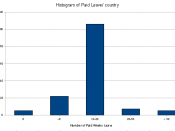Parental Leave in the United States"I second the amendment", Senator Henry starts her speech. "It is important to try to ensure that parental leave is paid because those parents who most need to be able to deal with problems concerning their children will not be able to take leave under the current provision" (Henry, 2005, Senate Speeches). Although a well developed country, the United States' parental leave legislation has not been an adequate substitute for parents to care for children as compared to most countries in the world.
After eight ears of debate and research in the workplace, the United States passed its legislation for parental leave rights. Parental leave grants the right for employees to take time off from work, paid or unpaid, to care for a child (Issues in Labor Statistics, 1993). The parental leave legislation, also known as the Family and Medical Leave Act of 1993 was developed in the United States when President Clinton signed into the law, February 15, 1993.
The FMLA policy is to provide 3 months of unpaid leave to working parents, unless paid leave was established in the parents' place of work. As a means to balance work and family responsibilities, the act is supposed to promote stability and the economic security of families, states the FMLA (2005). However, the act only requires companies to provide unpaid leave for the labor force to take care of these responsibilities outside of the workplace. How is unpaid leave suppose to provide stability and economic security for working parents?The number of women in the workplace has tripled since the 1950s (AFL-CIO, 2004). By 2003 47 percent of the U.S. workforces were women (AFL-CIO, 2004). In fact, 58 percent of working women with children earn about half or more of their total...


